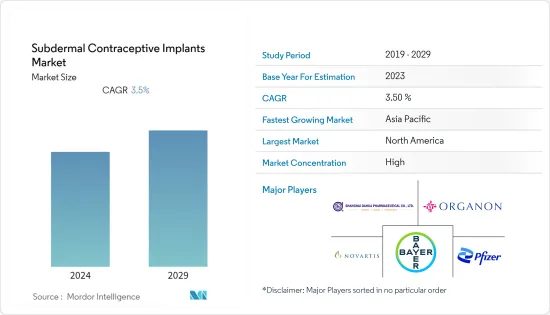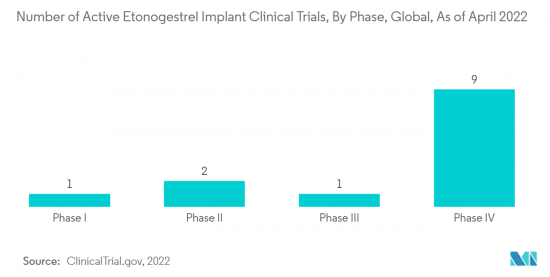
|
市場調査レポート
商品コード
1406074
皮下避妊インプラント:市場シェア分析、産業動向と統計、2024年~2029年の成長予測Subdermal Contraceptive Implants - Market Share Analysis, Industry Trends & Statistics, Growth Forecasts 2024 - 2029 |
||||||
カスタマイズ可能
適宜更新あり
|
|||||||
| 皮下避妊インプラント:市場シェア分析、産業動向と統計、2024年~2029年の成長予測 |
|
出版日: 2024年01月04日
発行: Mordor Intelligence
ページ情報: 英文 120 Pages
納期: 2~3営業日
|
全表示
- 概要
- 目次
概要
皮下避妊インプラント市場は予測期間でCAGR 3.5%を記録する見込み

主なハイライト
- COVID-19パンデミックは調査対象市場の成長に影響を与えました。当初、COVID-19の世界的流行と各国における閉鎖シナリオは、SARS-CoV-2ウイルスの蔓延を防ぐために病院や診療所がサービスの停止を余儀なくされるなど、市場にいくつかの課題を課していました。例えば、国連人口基金によると、2021年3月、COVID-19の大流行により、1,200万人以上の女性の家族計画サービスが中断し、140万人の計画外妊娠が発生しました。さらに、最初の封鎖期間中、女性は避妊にアクセスすることが困難になる可能性が9倍高くなり、その結果、予期せぬ出産が封鎖前の1.3%から封鎖後の2.1%へとほぼ倍増しました。
- さらに、国連性と生殖に関する保健機関(UNFPA)が2021年に実施した調査研究によると、COVID-19危機の結果、4,700万人以上の女性が避妊へのアクセスを失い、700万件の予期せぬ妊娠につながったといいます。このように、パンデミックの初期段階では、避妊具へのアクセスが低下したため、市場はマイナスの影響を目の当たりにしました。しかし、規制の緩和、ロックダウンの強化、COVID-19の症例の減少により、市場は勢いを増し始め、予測期間中も増加傾向が続くと予想されます。
- 望まない妊娠の増加と、それに伴う避妊法の使用促進への取り組みの増加が、市場の主な促進要因です。望まない妊娠の数は世界的に増加しており、世界中で深刻な問題となっています。例えば、国連人口基金によると、2022年3月には、望まない妊娠が世界の全妊娠の約半数を占め、毎年1億2,100万件発生しています。また、同資料によれば、予定外の妊娠の60.0%は中絶に至り、中絶全体の45.0%は安全でない中絶と推定され、その結果、妊産婦死亡者数の5~13%が死亡し、持続可能な開発目標を達成するための世界の能力が危険にさらされています。
- 同様に、2021年6月にNCBIが発表した論文によると、計画外妊娠はエチオピア最大のリプロダクティブ・ヘルス問題のひとつであり、そのすべての悪影響が観察されています。毎年、平均して493万人が妊娠し、190万人のエチオピアの女性(38%)が意図しない妊娠をしており、そのうち620,296人が人工妊娠中絶を行い、103,648人の女性が中絶に関連する合併症の治療を受けています。したがって、意図しない妊娠の割合が増加するにつれて、避妊器具の需要が急増し、それが最終的に予測期間中の市場成長の原動力となると思われます。
- さらに、望まない妊娠の増加を抑制する必要性を認識し、望まない中絶や妊娠の蔓延を教育し防止するために多くのイニシアチブを開始した国やそれぞれの政府があります。避妊ピルの使用もそのひとつです。避妊具を入手し使用する権利は、米国憲法が保障するプライバシーの基本的権利の一部です。例えば、米国国際開発庁(USAID)は、世界約40カ国で自発的な家族計画やリプロダクティブ・ヘルス(性と生殖に関する健康)の取り組みを推進・支援しています。このように、政府のイニシアチブも、不必要な出産や中絶を避けるために、避妊法の使用を推進しています。
- 同様に、民間企業も避妊具の使用を増やす取り組みを行っています。例えば、2022年9月、マンカインド・ファーマ社の経口避妊薬の定番ブランドであるアンウォンテッド21は、インドの世界避妊デーに際して多言語キャンペーンを開始しました。このキャンペーンは、家族計画とともに避妊の選択肢についての認識を高めることを目的としていました。従って、このような政府および民間の有利なイニシアチブは、予測期間中の市場成長を促進すると予想されます。
- しかし、不妊症の有病率の上昇、認知度の不足、避妊インプラントの副作用が市場成長を抑制する可能性が高いです。
皮下避妊インプラント市場動向
エトノゲストレルインプラントセグメントは予測期間中にかなりの成長が見込まれる
- エトノゲストレルインプラント分野は、高い臨床的有効性と高い採用率などの要因により、予測期間中に大きな成長が見込まれます。エトノゲストレルは排卵を防ぐホルモンです。この薬はまた、子宮頸管粘液と子宮内膜に変化をもたらし、精子が子宮に到達しにくくなり、受精卵が子宮に付着しにくくなります。
- エトノゲストレル皮下インプラントは、妊娠を予防するための避妊薬として使用されます。この薬は小さなプラスチックの棒の中に入っており、上腕の皮下に埋め込みます。薬はゆっくりと体内に放出されます。インプラントはそのままの位置に留まり、最長3年間継続的に避妊することができます。
- 製品上市、各国での製品上場、合併、分社化など、さまざまな事業戦略の採用に注力する企業が増えていることが、予測期間中の市場成長を押し上げるとみられます。例えば、メルクは2021年6月にオルガノンを分社化し、ウィメンズヘルス企業として独立させました。同社は、避妊・排卵誘発ブランド、皮膚科、呼吸器科、骨の健康製品などのポートフォリオで女性ヘルスケア事業を展開します。さらに2022年1月、オルガノンはオンタリオ州(オンタリオ州医薬品給付プログラム)、ブリティッシュ・コロンビア州(BCファーマケア)、ノバスコシア州(ノバスコシア・ファーマケア)におけるネクスプラノン(エトノゲストレル徐放性皮下埋め込み型製剤)の公示を発表しました。
- 同様に、2021年11月、オルガノンは、ケベック州におけるRAMQ(Regie de l'assurance Maladie du Quebec:ケベック州医療保障制度)に基づくNEXPLANON(エトノゲストレル徐放性皮下埋め込み型製剤)の公示を発表しました。このように、承認と製品上市の増加は、エトノゲストレルインプラントの需要を増加させる可能性が高いです。したがって、予測期間中にかなりの成長が見込まれます。

北米は予測期間中、優位性を維持する見込み
- 北米は予測期間中にかなりの成長が見込まれます。この成長は、望まない妊娠や中絶率の上昇、技術の進歩、政府の支援策などの要因によるものです。例えば、Guttmacher Instituteによると、2022年3月、北米では2020年から2022年の間に年間5,660,000件以上の妊娠があり、そのうち2,590,000件が望まない妊娠で、886,000件が中絶に至っています。
- さらに同じ情報源によれば、カナダでは2020年から2022年の間に年間57万件以上の妊娠があり、そのうち26万5000件が望まない妊娠で、9万7500件が中絶に至っています。このように、望まない妊娠や中絶率の増加は、皮下避妊インプラントの需要を増加させ、北米地域の市場成長を高める可能性が高いです。
- 主要製品の発売、市場プレイヤーやメーカーのプレゼンスの集中、主要プレイヤー間の買収や提携、米国における避妊技術に対する取り組みの高まりは、同国の皮下避妊インプラント市場の成長を促進する要因の一部です。
- 例えば、2022年に発表されたビル&メリンダ・ゲイツ財団のデータによると、同財団は2021年から2030年にかけて、新しく改良された避妊技術の開発に年間2億8,000万米ドルを提供し、地域コミュニティの好みを反映した家族計画プログラムを支援し、女性と女児が避妊ケアをコントロールできるようにすることを目指しています。したがって、望まない妊娠や中絶の発生率の上昇と前述の市場開拓が、同国における皮下避妊インプラントの採用を後押しし、予測期間中の市場成長を押し上げると予想されます。
皮下避妊インプラント産業の概要
世界の皮下避妊インプラント市場は競争と統合が激しく、大手企業はごく少数です。主要企業の中には、オルガノン、上海大華製薬、バイエルAGなどがあり、市場でかなりのシェアを占めています。
その他の特典:
- エクセル形式の市場予測(ME)シート
- 3ヶ月間のアナリストサポート
目次
第1章 イントロダクション
- 調査の前提条件と市場の定義
- 調査範囲
第2章 調査手法
第3章 エグゼクティブサマリー
第4章 市場力学
- 市場概要
- 市場促進要因
- 避妊法普及に向けた取り組みの増加
- 望まない妊娠の増加
- 市場抑制要因
- 不妊症の増加
- 避妊インプラントの認識不足と副作用
- ポーターのファイブフォース分析
- 新規参入業者の脅威
- 買い手/消費者の交渉力
- 供給企業の交渉力
- 代替品の脅威
- 競争企業間の敵対関係の強さ
第5章 市場セグメンテーション(市場規模)
- タイプ別
- エトノゲストレルインプラント
- レボノルゲストレルインプラント
- 地域別
- 北米
- 米国
- カナダ
- メキシコ
- 欧州
- ドイツ
- 英国
- フランス
- イタリア
- スペイン
- その他の欧州
- アジア太平洋
- 中国
- 日本
- インド
- オーストラリア
- 韓国
- その他のアジア太平洋
- 中東・アフリカ
- GCC
- 南アフリカ
- その他の中東・アフリカ
- 南米
- ブラジル
- アルゼンチン
- その他の南米
- 北米
第6章 競合情勢
- 企業プロファイル
- Merck & Co., Inc
- Organon
- Shanghai Dahua Pharmaceutical Co., Ltd.
- Bayer AG
- Pfizer(Wyeth Pharmaceuticals Inc.)
- Novartis AG
第7章 市場機会と今後の動向
目次
Product Code: 69205

The subdermal contraceptive implants market is expected to register a CAGR of 3.5% over the forecast period.
Key Highlights
- The COVID-19 pandemic impacted the growth of the studied market. Initially, the global COVID-19 outbreak and the lockdown scenario in various countries had imposed some challenges on the market, as hospitals and clinics were forced to suspend services to prevent the spread of the SARS-CoV-2 virus. For instance, according to the United Nations Population Fund, in March 2021, the COVID-19 pandemic disrupted the family planning services of more than 12.0 million women, resulting in 1.4 million unplanned pregnancies. In addition, during the initial lockdown, women were nine times more likely to have difficulty accessing contraception, resulting in an almost doubling of unexpected births, from 1.3% pre-lockdown to 2.1% post-lockdown.
- Furthermore, according to the research study conducted by the United Nations Sexual and Reproductive Health Agency (UNFPA) in 2021, more than 47.0 million women lost access to contraception, leading to 7.0 million unintended pregnancies as a result of the COVID-19 crisis. Thus, during the initial phase of the pandemic, due to lower access to contraceptives, the market witnessed a negative impact. However, with the ease of restrictions, lockdown upliftments, and decreasing cases of COVID-19, the market started to gain momentum and is expected to continue the upward trend over the forecast period.
- The increasing number of unwanted pregnancies and, thereby, the rising number of initiatives to promote the use of contraceptive methods are the major drivers for the market. The number of unwanted pregnancies is increasing globally, and it is a matter of serious concern all around the world. For instance, according to the United Nations Population Fund, in March 2022, unintended pregnancies accounted for about half of all pregnancies worldwide, with 121.0 million occurring each year. The same source also stated that 60.0% of unplanned pregnancies end in abortion, with an estimated 45.0% of all abortions being unsafe, resulting in 5-13% of all maternal fatalities, putting the world's capacity to meet the Sustainable Development Goals at risk.
- Similarly, according to an article published by the NCBI in June 2021, it has been observed that unplanned pregnancy is one of Ethiopia's biggest reproductive health issues, with all of its negative consequences. Every year, on average, 4.93 million pregnancies occur, with 1.9 million Ethiopian women (38%) having an unintended pregnancy, of which 620,296 induced abortions were performed, and 103,648 women were treated for abortion-related complications. Hence, with the increasing rate of unintended pregnancies, there will be a rapid increase in the demand for contraceptive devices, which will ultimately drive market growth over the forecast period.
- Furthermore, there are countries and their respective governments that have identified the need to curb the growth of unwanted pregnancies and have started a great number of initiatives to educate and prevent the spread of unwanted abortions and pregnancies. The usage of contraceptive pills is one of them. The right to obtain and use contraceptives is part of the fundamental right to privacy guaranteed by the United States Constitution. For instance, the United States Agency for International Development (USAID) promotes and supports voluntary family planning and reproductive health initiatives in approximately 40 countries throughout the world. Thus, government initiatives are also promoting the use of contraceptive methods to avoid unnecessary births and abortions.
- Similarly, the private sector is also taking initiatives to increase the use of contraceptives. For instance, in September 2022, Unwanted 21, the regular oral contraceptive brand from Mankind Pharma, launched a multilingual campaign on the occasion of World Contraception Day in India. The campaign was aimed at creating awareness about contraceptive options along with family planning. Therefore, such favorable government and private initiatives are anticipated to propel the market growth over the forecast period.
- However, the rising prevalence of infertility, lack of awareness, and adverse effects of contraceptive implants are likely to restrain the market growth.
Subdermal Contraceptive Implants Market Trends
Etonogestrel Implant Segment is Expected to Witness Considerable Growth Over the Forecast Period
- The etonogestrel implant segment is expected to witness significant growth over a forecast period owing to factors such as high clinical effectiveness and high adoption rate. Etonogestrel is a hormone that prevents ovulation. This medication also causes changes in the cervical mucus and uterine lining, making it harder for sperm to reach the uterus and harder for a fertilized egg to attach to the uterus.
- Subdermal etonogestrel implant is used as contraception to prevent pregnancy. The medicine is contained in a small plastic rod that is implanted under the skin of the upper arm. The medicine is released slowly into the body. The rod can remain in place and provide continuous contraception for up to 3 years.
- The increasing company focus on adopting various business strategies such as product launches, listing products in the countries, mergers, and company spin-offs are likely to boost the growth of the market over the forecast period. For instance, in June 2021, Merck spun off Organon to make it an independent Women's Health company. The company will operate in women's healthcare with a portfolio of contraceptive and fertility brands, dermatology, respiratory, and bone health products. In addition, in January 2022, Organon announced the public listings for NEXPLANON (etonogestrel extended-release subdermal implant) in Ontario (Ontario Drug Benefit Program), British Columbia (BC PharmaCare), and Nova Scotia (Nova Scotia PharmaCare).
- Similarly, in November 2021, Organon announced the public listings for NEXPLANON (etonogestrel extended-release subdermal implant) in Quebec under the Regie de l'assurance Maladie du Quebec (RAMQ). Thus, the increasing approvals and product launches are likely to increase the demand for etonogestrel implants. Therefore, considerable segment growth is anticipated over the forecast period.

North America is Expected to Maintain Dominance during the Forecast Period
- North America is expected to witness considerable growth over the forecast period. The growth is due to factors such as rising cases of unwanted pregnancies and high abortion rates, technological advancements, as well as supportive government schemes. For instance, according to the Guttmacher Institute, in March 2022, there were more than 5,660,000 pregnancies annually between 2020 and 2022, of which 2,590,000 were unwanted, and 886,000 resulted in abortion in North America.
- Furthermore, as per the same source, in Canada, there were more than 570,000 pregnancies annually between 2020 and 2022, of which 265,000 were unwanted, and 97,500 resulted in abortion. Thus, the increasing cases of unwanted pregnancies and abortion rates are likely to increase the demand for subdermal contraceptive implants, thereby increasing market growth in the North American region.
- Key product launches, high concentration of market players or manufacturers' presence, acquisition and & partnerships among major players, and rising initiatives towards contraceptive technologies in the United States are some of the factors driving the growth of the subdermal contraceptive implants market in the country.
- For instance, as per the Bill & Melinda Gates Foundation data published in 2022, the foundation is aiming to offer USD 280.0 million per year from 2021 to 2030 for developing new and improved contraceptive technologies, support family planning programs that reflect the preferences of local communities, and enable women and girls to be in control of their contraceptive care. Thus, the rising incidences of unwanted pregnancies and abortion rates and the aforementioned developments are anticipated to boost the adoption of subdermal contraceptive implants in the country, thereby boosting market growth over the forecast period.
Subdermal Contraceptive Implants Industry Overview
The global subdermal contraceptive implants market is competitive and consolidated and consists of very few major players. Some of the key companies are Organon, Shanghai Dahua Pharmaceutical Co., Ltd., and Bayer AG, among others, which hold a substantial market share in the market.
Additional Benefits:
- The market estimate (ME) sheet in Excel format
- 3 months of analyst support
TABLE OF CONTENTS
1 INTRODUCTION
- 1.1 Study Assumptions and Market Defination
- 1.2 Scope of the Study
2 RESEARCH METHODOLOGY
3 EXECUTIVE SUMMARY
4 MARKET DYNAMICS
- 4.1 Market Overview
- 4.2 Market Drivers
- 4.2.1 Rise in the Number of Initiatives to Promote Contraceptive Methods
- 4.2.2 Increasing Number of Unwanted Pregnancies
- 4.3 Market Restraints
- 4.3.1 Rising Prevalence of Infertility
- 4.3.2 Lack of Awareness and Adverse Effects of Contraceptive Implants
- 4.4 Porter's Five Forces Analysis
- 4.4.1 Threat of New Entrants
- 4.4.2 Bargaining Power of Buyers/Consumers
- 4.4.3 Bargaining Power of Suppliers
- 4.4.4 Threat of Substitute Products
- 4.4.5 Intensity of Competitive Rivalry
5 MARKET SEGMENTATION (Market Size by Value - USD)
- 5.1 By Type
- 5.1.1 Etonogestrel Implant
- 5.1.2 Levonorgestrel Implant
- 5.2 Geography
- 5.2.1 North America
- 5.2.1.1 United States
- 5.2.1.2 Canada
- 5.2.1.3 Mexico
- 5.2.2 Europe
- 5.2.2.1 Germany
- 5.2.2.2 United Kingdom
- 5.2.2.3 France
- 5.2.2.4 Italy
- 5.2.2.5 Spain
- 5.2.2.6 Rest of Europe
- 5.2.3 Asia Pacific
- 5.2.3.1 China
- 5.2.3.2 Japan
- 5.2.3.3 India
- 5.2.3.4 Australia
- 5.2.3.5 South Korea
- 5.2.3.6 Rest of Asia-Pacific
- 5.2.4 Middle East and Africa
- 5.2.4.1 GCC
- 5.2.4.2 South Africa
- 5.2.4.3 Rest of Middle East and Africa
- 5.2.5 South America
- 5.2.5.1 Brazil
- 5.2.5.2 Argentina
- 5.2.5.3 Rest of South America
- 5.2.1 North America
6 COMPETITIVE LANDSCAPE
- 6.1 Company Profiles
- 6.1.1 Merck & Co., Inc
- 6.1.2 Organon
- 6.1.3 Shanghai Dahua Pharmaceutical Co., Ltd.
- 6.1.4 Bayer AG
- 6.1.5 Pfizer (Wyeth Pharmaceuticals Inc.)
- 6.1.6 Novartis AG

